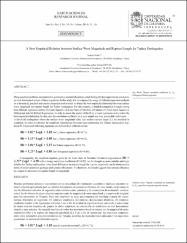| dc.contributor.author | Öztürk, Serkan | |
| dc.date.accessioned | 2019-12-10T11:50:50Z | |
| dc.date.available | 2019-12-10T11:50:50Z | |
| dc.date.issued | 2014 | |
| dc.identifier.issn | 1794-6190 | |
| dc.identifier.issn | 2339-3459 | |
| dc.description.abstract | Many practical problems encountered in quantitative oriented disciplines entail finding the best approximate solution to an over determined system of linear equations. In this study, it is investigated the usage of different regression methods as a theoretical, practical and correct estimation tool in order to obtain the best empirical relationship between surface wave magnitude and rupture length for Turkey earthquakes. For this purpose, a detailed comparison is made among four different regression norms: (1) Least Squares, (2) Least Sum of Absolute Deviations, (3) Total Least Squares or Orthogonal and, (4) Robust Regressions. In order to assess the quality of the fit in a linear regression and to select the best empirical relationship for data sets, the correlation coefficient as a quite simple and very practicable tool is used. A list of all earthquakes where the surface wave magnitude (Ms) and surface rupture length (L) are available is compiled. In order to estimate the empirical relationships between these parameters for Turkey earthquakes, loglinear fit is used and following equations are derived from different norms: Ms = 1.02* LogL + 5.18, for L-2 Norm regression (R-2=0.71), Ms = 1.15* LogL + 4.98, for L-1 Norm regression (R-2=0.92), Ms = 1.04* LogL + 5.15, for Robust regression (R-2=0.75), Ms = 1.25* LogL + 4.86, for Orthogonal regression (R-2=0.68), Consequently, the empirical equation given by the Least Sum of Absolute Deviations regression as Ms = 1.15* LogL + 4.98 with a strong correlation coefficient (R-2=0.92) can be thought as more suitable and more reliable for Turkey earthquakes. Also, local differences in rupture length for a given magnitude can be interpreted in terms of local variation in geologic and seismic efficiencies. Furthermore, this result suggests that seismic efficiency in a region is dependent on rupture length or magnitude. | en_US |
| dc.description.sponsorship | Gumushane University (Turkey)Gumushane University [2012.02.1717.2] | en_US |
| dc.description.sponsorship | The author would like to thank to Professor Dr. Hakan KARSLI for his helps in preparing the analysis codes and anonymous reviewers for their useful and constructive suggestions in improving this paper. Also, the computer programs used in this study are partially covered by Gumushane University (Turkey) with project no 2012.02.1717.2. | en_US |
| dc.language.iso | eng | en_US |
| dc.publisher | Univ Nacional De Colombia | en_US |
| dc.relation.ispartof | Earth Sciences Research Journal | en_US |
| dc.rights | info:eu-repo/semantics/openAccess | en_US |
| dc.subject | [No Keywords] | en_US |
| dc.title | A New Empirical Relation between Surface Wave Magnitude and Rupture Length for Turkey Earthquakes | en_US |
| dc.type | article | en_US |
| dc.relation.publicationcategory | Makale - Uluslararası Hakemli Dergi - Kurum Öğretim Elemanı | en_US |
| dc.description.wospublicationid | WOS:000351880500002 | en_US |
| dc.department | Fakülteler, Mühendislik ve Doğa Bilimleri Fakültesi, Jeofizik Mühendisliği Bölümü | en_US |
| dc.authorid | Öztürk, Serkan / 0000-0003-1322-5164 | |
| dc.identifier.volume | 18 | en_US |
| dc.identifier.issue | 1 | en_US |
| dc.identifier.startpage | 15 | en_US |
| dc.identifier.endpage | 26 | en_US |
| dc.authorwosid | Öztürk, Serkan / ABI-5194-2020 | |


















